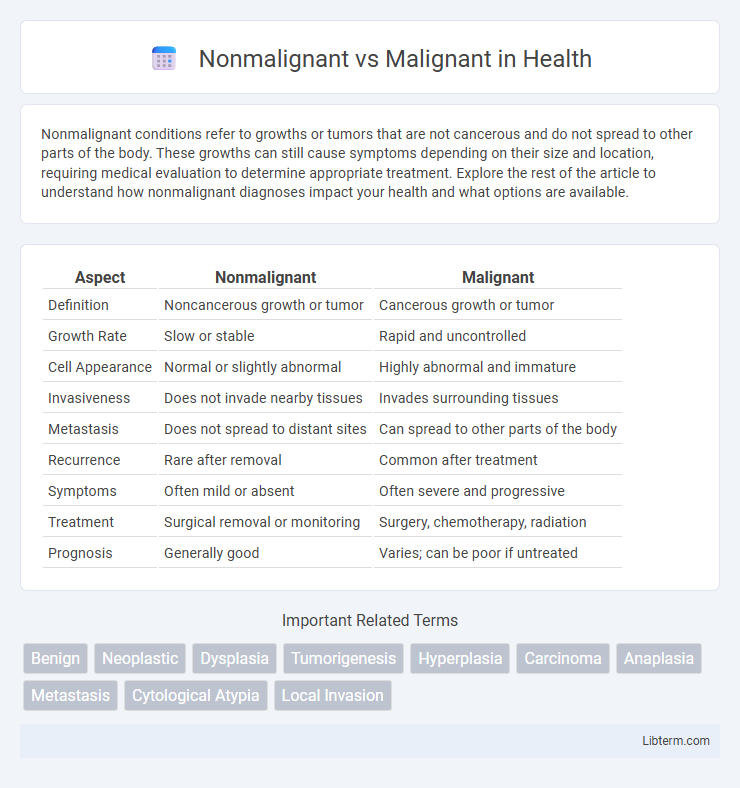Nonmalignant conditions refer to growths or tumors that are not cancerous and do not spread to other parts of the body. These growths can still cause symptoms depending on their size and location, requiring medical evaluation to determine appropriate treatment. Explore the rest of the article to understand how nonmalignant diagnoses impact your health and what options are available.
Table of Comparison
| Aspect | Nonmalignant | Malignant |
|---|---|---|
| Definition | Noncancerous growth or tumor | Cancerous growth or tumor |
| Growth Rate | Slow or stable | Rapid and uncontrolled |
| Cell Appearance | Normal or slightly abnormal | Highly abnormal and immature |
| Invasiveness | Does not invade nearby tissues | Invades surrounding tissues |
| Metastasis | Does not spread to distant sites | Can spread to other parts of the body |
| Recurrence | Rare after removal | Common after treatment |
| Symptoms | Often mild or absent | Often severe and progressive |
| Treatment | Surgical removal or monitoring | Surgery, chemotherapy, radiation |
| Prognosis | Generally good | Varies; can be poor if untreated |
Introduction to Nonmalignant and Malignant Conditions
Nonmalignant conditions refer to abnormal growths or lesions that do not invade surrounding tissues or spread to other parts of the body, often resulting in benign tumors. Malignant conditions involve cancerous cells that demonstrate uncontrolled growth, invasion into adjacent tissues, and the potential to metastasize. Understanding the biological differences between nonmalignant and malignant states is crucial for accurate diagnosis, treatment planning, and prognosis evaluation in clinical practice.
Defining Nonmalignant: Key Characteristics
Nonmalignant tumors are characterized by their non-invasive growth, limited potential for metastasis, and generally slow progression compared to malignant tumors. Key characteristics include well-defined borders, lack of cellular atypia, and minimal impact on surrounding tissues, making them less aggressive and easier to treat. These tumors often remain localized and pose a lower risk to health, distinguishing them fundamentally from malignant neoplasms.
Understanding Malignancy: What Makes a Condition Malignant
Malignancy refers to the presence of cancerous cells that grow uncontrollably, invade nearby tissues, and have the potential to spread to distant organs through metastasis. Nonmalignant conditions, also known as benign, typically exhibit slow growth, remain localized, and do not invade surrounding tissues or metastasize. The key factors distinguishing malignant conditions include abnormal cell division, genetic mutations, loss of apoptosis, and the ability to degrade extracellular matrices, facilitating tissue invasion and distant spread.
Differences in Cell Behavior: Nonmalignant vs Malignant
Nonmalignant cells exhibit controlled growth and maintain normal tissue architecture, while malignant cells demonstrate uncontrolled proliferation and invade surrounding tissues. Unlike nonmalignant cells, malignant cells possess the ability to metastasize, spreading to distant organs via the bloodstream or lymphatic system. Cellular mechanisms such as apoptosis resistance and angiogenesis activation are prominent in malignant cells, contributing to tumor progression and malignancy.
Growth Patterns: Benign Versus Malignant Tumors
Benign tumors exhibit slow, localized growth with well-defined borders and encapsulation, preventing invasion into surrounding tissues. Malignant tumors demonstrate rapid, aggressive growth with irregular, infiltrative edges that invade adjacent structures and metastasize to distant sites. These distinct growth patterns are critical for diagnosis and treatment planning in oncology.
Metastasis: The Defining Feature of Malignant Cells
Malignant cells are characterized by their ability to metastasize, spreading from the primary tumor site to distant organs through the bloodstream or lymphatic system, a process absent in nonmalignant tumors. This metastatic capability distinguishes malignant tumors, contributing to their aggressive nature and complexity in treatment. Nonmalignant tumors, by contrast, remain localized and do not invade surrounding tissues or metastasize, making them less threatening to overall health.
Symptoms and Clinical Manifestations
Nonmalignant tumors often present with localized symptoms such as swelling, pain, or dysfunction related to pressure on adjacent tissues, typically exhibiting slow growth and well-defined borders on imaging. In contrast, malignant tumors frequently cause systemic symptoms including unexplained weight loss, fatigue, night sweats, and may present with rapidly enlarging masses, invasive tissue destruction, and metastasis evidenced by lymphadenopathy or organ dysfunction. Clinical manifestations of malignancy often involve abnormal laboratory findings like elevated tumor markers, anemia, or hypercalcemia, distinguishing them from the generally stable profiles seen in benign conditions.
Diagnosis: Distinguishing Nonmalignant from Malignant
Accurate diagnosis between nonmalignant and malignant tumors relies on histopathological examination, imaging studies like MRI or CT scans, and biomarker analysis to identify cellular abnormalities and aggressive growth patterns. Nonmalignant lesions typically demonstrate well-defined borders and slow growth with limited invasion, whereas malignant tumors show irregular margins, rapid proliferation, and potential metastasis. Molecular testing, including genetic mutation analysis, further aids in differentiating malignancy by revealing oncogene activation or tumor suppressor gene loss.
Treatment Strategies for Nonmalignant and Malignant Conditions
Treatment strategies for nonmalignant conditions typically involve conservative management such as medication, physical therapy, or minimally invasive procedures aimed at symptom relief and quality of life improvement. Malignant conditions require aggressive approaches including surgery, chemotherapy, radiation therapy, or targeted biological treatments to eradicate cancerous cells and prevent metastasis. Personalized treatment plans based on tumor type, stage, and patient health are critical to optimizing outcomes in malignant cases.
Prognosis and Long-Term Outcomes
Nonmalignant tumors generally have a favorable prognosis with limited risk of invasion or metastasis, leading to better long-term outcomes and higher survival rates. Malignant tumors tend to exhibit aggressive behavior, including local invasion and distant metastasis, often resulting in poorer prognosis and increased mortality. Long-term outcomes for malignant cases frequently depend on early detection, treatment efficacy, and tumor stage at diagnosis.
Nonmalignant Infographic

 libterm.com
libterm.com